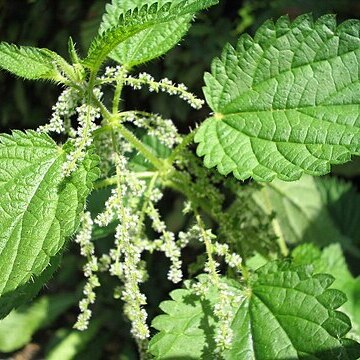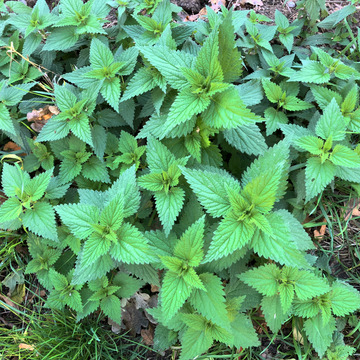Herbs, rarely subshrubs, annual or perennial, armed with stinging hairs. Stems often 4-angled. Leaves opposite; stipules often persistent, interpetiolar, lateral, free or connate; leaf blade 3-5(-7)-veined, margin dentate or incised-lobed; cystoliths often punctiform, sometimes short botuliform. Inflorescences in axillary pairs; glomerules forming spikes, racemes, panicles, or rarely capitula, unisexual (plants monoecious or dioecious) or androgynous. Male flowers: perianth lobes 4, imbricate; stamens 4; rudimentary ovary cuplike. Female flowers: perianth lobes 4, free or connate, enlarged in fruit, enclosing achene, strongly unequal, outer 2 (lateral) smaller than inner 2 (dorsal-ventral) lobes. Ovary straight; stigma sessile or on short style, penicillate-capitate. ovule orthotropous. Achene straight, compressed, enclosed by persistent perianth. Seed erect, with scanty endosperm; cotyledons suborbicular, fleshy.
Annual or perennial herbs, monoecious or dioecious. Stems with stinging and sometimes stiff hairs. Leaves opposite, petiolate, simple; stipules lateral, free, or interpetiolar, fused; cystoliths punctiform. Inflorescences axillary, mostly shortly pedunculate, often paired in each leaf-axil, bisexual or unisexual lax cymose panicles. Flowers unisexual, 4-merous, usually clustered in small cymose glomerules. Male flowers: tepals free, in 2 subequal pairs; rudimentary ovary present. Female flowers: tepals free, in 2 ± unequal pairs; staminodes absent; ovary ovoid, laterally compressed, symmetrical; stigma sessile, penicillate. Achene enclosed in or released from the persistent perianth, lenticular with a ± raised central area on each face.
Herbs, monoecious, rarely dioecious, with irritant hairs. Leaves opposite-decussate, petiolate, simple, dentate to incised, very rarely subentire, with 3 or 5 veins; cystoliths mainly punctiform; stipules free and lateral to connate and intrapetiolar. Inflorescences axillary, paired interrupted spikes or panicles, unisexual or bisexual. Male flowers: tepals 4, free, with irritant hairs; stamens 4; pistillode cupuliform, translucent. Female flowers: tepals 4, 1 opposite pair larger than other; pistil straight; style short or absent; stigma penicillate-capitate. Achene laterally compressed, ovoid, enclosed by tepals.
Fls small, greenish, unisexual, in axillary simple or branched spikes or racemes; per. deeply 4-partite; stamens 4, inflexed in bud; ovary us. ovoid; stigma penicillate; ovule 1, erect. Achene us. ovoid; subcompressed, invested by long-persistent per. About 40 spp., mostly temperate and subtropical, of annual to perennial herbs or shrubs, us, bearing stinging hairs; lvs opp., toothed or lobed. The N.Z. spp. are endemic, except U. incisa, which is common in Australia and Tasmania.
Dioecious or monoecious; male fls with 4 subequal sep, 4 stamens, and vestigial ovary; sep of the female fls unequal, the outer 2 small and inconspicuous; stigma capitate-tufted; fr a lenticular achene enclosed by the 2 inner sep; herbs with opposite lvs, ± beset with stinging bristles; fls minute, in panicles, spikes, or head-like clusters from the upper axils. 25, widespread.
Annual or perennial, monoecious or dioecious herbs or shrubs, usually with stinging hairs. Lvs opposite, toothed, stipulate. Infl. axillary, usually spike-like with clustered cymes, ebracteolate. Perianth green, 4-partite, not connate at base; ♀ fls with ± unequal perianth segments, the 2 larger enclosing achene; ♂ fls with 4 equal segments.


